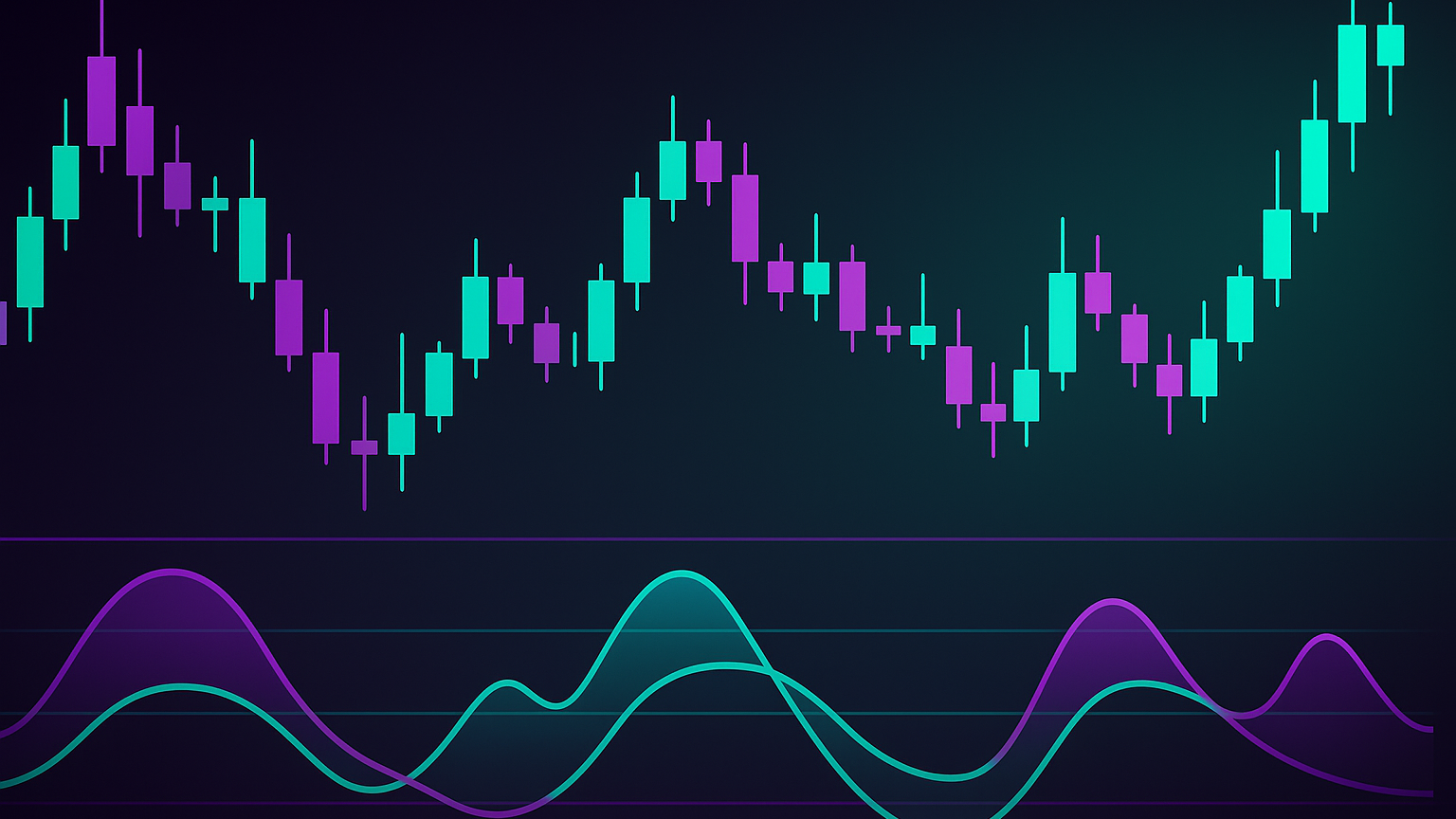Learn swing trading strategies to profit from market volatility using key indicators and risk management techniques.
Swing trading is a way to profit from short- to medium-term price movements in the market, usually holding positions for days or weeks. It relies on market volatility to identify opportunities using tools like moving averages, RSI, and Bollinger Bands. Here's what you need to know:
- Why Swing Trade?
- Less time-intensive than day trading.
- Cost-efficient with fewer trades and higher potential profits per trade.
- Works best in moderately volatile markets.
- Key Strategies:
- Trend Trading: Trade with the trend during pullbacks.
- Range Trading: Buy at support, sell at resistance in sideways markets.
- Breakout Trading: Enter after price breaks key levels with volume confirmation.
- Risk Management:
- Risk only 1-2 % of your account per trade.
- Use stop-loss orders based on technical levels.
- Aim for at least a 1 : 2 risk-reward ratio.
Swing trading balances technical analysis, strategy, and risk management to capitalize on price swings effectively. Start with a clear plan, test your approach, and adjust for different market conditions.
The Ultimate Swing Trading Guide For Beginners
Key Technical Indicators
Moving averages, RSI, Bollinger Bands, and volume analysis work together to create a structured approach for identifying swing-trading opportunities. Each tool complements the others to form a well-rounded strategy.
Moving Averages
Moving averages help smooth out price data, making it easier to spot trends and determine entry and exit points. Traders often rely on different timeframes for specific purposes:
| Timeframe | Moving Average Period | Purpose |
|---|---|---|
| Long-term | 200 days | Identifies overall trend direction |
| Medium-term | 50 days | Highlights intermediate support/resistance levels |
| Short-term | 10-20 days | Guides entry and exit timing |
Both Simple Moving Averages (SMAs) and Exponential Moving Averages (EMAs) are widely used. As Marty Schwartz explains:
“The 10-day exponential moving average (EMA) is my favorite indicator to determine the major trend. I call this ‘red light, green light.’ Trading above the 10-day EMA signals a positive trend—think buy; below indicates a negative trend—think sell.”
RSI Trading Guide
The Relative Strength Index (RSI) is a tool for spotting overbought and oversold conditions. Research shows that RSI-based strategies can achieve up to a 91 % success rate.
Key RSI signals include:
- Overbought: Readings above 70 suggest selling opportunities.
- Oversold: Readings below 30 suggest buying opportunities.
- Trend Confirmation: A rising RSI supports an uptrend, while a falling RSI confirms a downtrend.
For shorter timeframes, adjusting RSI levels to 15 for oversold and 85 for overbought can help capture quicker market swings.
Using Bollinger Bands
Bollinger Bands measure market volatility and help identify potential entry points. For instance, when Bollinger Bands tighten during a sideways market and RSI hovers near 55, a surge in volume above the upper band often signals a bullish breakout. This naturally ties into volume analysis, which validates such signals.
Volume Analysis
Volume is crucial for confirming price movements. High breakout volume indicates strong trend shifts, while low volume at extreme prices often signals potential reversals. For example, if a currency pair breaks below the lower Bollinger Band with RSI under 30 and sees a spike in sell volume, it creates a short entry opportunity. Combining multiple indicators—like a bounce off moving-average support, oversold RSI, and rising volume—can lead to reliable trading setups.
3 Proven Trading Strategies
Here are three swing-trading strategies designed to navigate market ups and downs, using key technical indicators.
Trend Trading Method
- Spot the Trend: Use moving averages and price patterns to confirm the trend. Look for higher highs and lows in an uptrend or lower highs and lows in a downtrend.
- Find Entry Points: Enter trades during pullbacks. In an uptrend, this means buying near support levels; in a downtrend, look to sell near resistance. Candlestick patterns, volume spikes, or momentum shifts can confirm your entry.
- Plan Your Exit: Set profit targets at previous swing highs or lows. Use trailing stops to lock in profits and exit if signs of a trend reversal emerge.
Trading Price Ranges
- Define the Range: Identify consistent support and resistance levels using historical price data.
- Enter at Key Levels: Take positions near support or resistance when technical signals, like candlestick patterns, suggest a reversal.
- Manage Positions Carefully: Scale into trades gradually and stick to strict risk-management rules.
Trading Market Breakouts
- Confirm the Breakout: Look for strong moves beyond key price levels, supported by higher-than-usual trading volume. A small pullback can further validate the breakout.
- Time Your Entry: Enter after a brief pullback post-breakout to optimize your risk/reward ratio.
- Control Your Risk: Place stop-loss orders just beyond the breakout level. Ensure the breakout is supported by volume to avoid false moves.
Risk-Management Rules
Managing risk is a cornerstone of successful swing trading. Without the right safeguards, even the most effective strategies can lead to losses. These guidelines help you quantify and control your trades.
Position-Size Calculator
Position sizing helps you decide how many shares to trade based on your risk tolerance:
- Set Risk Per Trade: Limit your risk to no more than 1-2 % of your total trading capital on a single trade.
- Calculate Share Size: Use this formula:
(Account Size × Risk Percentage) ÷ (Entry Price − Stop-Loss Price) = Number of Shares. - Adjust for Volatility: Lower your position size in highly volatile markets.
Example:
If you have a $20,000 account and risk 1 % ($200) per trade, with a $2 difference between the entry and stop-loss price:
- Maximum position size = $200 ÷ $2 = 100 shares.
Stop-Loss Placement
After determining your position size, setting effective stop losses is your next layer of protection.
“A stop loss is a crucial element in controlling risk on a stock trade.”
Key points for placing stop losses:
- Base stops on technical levels, not random price points.
- Use the Average True Range (ATR) indicator to factor in market volatility.
- For long trades, place stops just below established support levels.
- For short trades, set stops just above resistance levels.
In highly volatile markets, consider using the ATR percentage-stop method.
Risk vs Reward
Aim for a risk-reward ratio of at least 1 : 2. For example, risking $200 should target a minimum profit of $400.
| Trading Style | Win Rate | Risk : Reward | Monthly Profit Potential* |
|---|---|---|---|
| High R/R | 33 % | 5 : 1 | $6,000 |
| Balanced | 60 % | 2.5 : 1 | $6,600 |
*Based on a $20,000 account
“Profitable and consistent trading is about finding a balance between your win rate and risk/reward ratio. Here’s how to do it.” – Cory Mitchell, CMT
Tools and Implementation
Swing trading thrives on the right tools and a structured approach. Today’s platforms make it easier to test and execute strategies effectively.
Testing Your Strategy
Backtesting with LuxAlgo’s AI Backtesting Assistant provides the following results:
| Performance Metric | Result |
|---|---|
| Total Trades | 107 |
| Win Rate | 82.24 % |
| Net Profit | $97.02 |
| Average Trade | $0.907 |
| Profit Factor | 1.251 |
| Maximum Drawdown | 0.86 % |
These figures confirm the effectiveness of your strategy. The platform also enables fine-tuning across different timeframes and market conditions. Beyond backtesting, specialized tools can help refine your trading approach even further.
Technical Analysis Tools
LuxAlgo offers two powerful toolkits to elevate your swing-trading game:
- Signals & Overlays (S&O)
This toolkit delivers actionable entry and exit signals, customizable overlays, and advanced alerts. It’s designed to be user-friendly for beginners while offering depth for seasoned traders. - Oscillator Matrix (OSC)
The OSC toolkit focuses on trend-following, real-time divergence detection, and money-flow analysis. It’s a great resource for identifying trends and potential reversals.
Adapting to Market Conditions
Adjusting your strategy based on market behavior is key. Here’s how to approach different scenarios:
- Bull Markets
Look for long positions above short-term moving averages. Watch for breakouts with rising volume and use pullbacks to support levels for entries. - Bear Markets
Explore short-selling opportunities and focus on oversold conditions for potential rebounds. Tighten your stop-loss settings to manage risk. - Range-Bound Markets
Trade within support and resistance levels. Look for consolidation patterns like triangles or flags, and use oscillators to spot overbought or oversold zones.
Conclusion
Main Points Review
Swing trading combines technical analysis, well-thought-out strategies, and disciplined risk management. Tools like moving averages, RSI, and Bollinger Bands help identify potential trade opportunities. Many traders stick to a minimum 1 : 2 risk-reward ratio, which, along with the 1 % risk rule, provides a solid foundation for consistent results.
| Trading Component | Implementation Approach | Expected Benefit |
|---|---|---|
| Technical Analysis | Use multiple indicators for confirmation | Better timing for entries/exits |
| Risk Management | Limit risk to 1 % per trade | Reduced potential losses |
| Position Sizing | Adjust based on stop-loss distance | Stable risk across trades |
These elements create a clear path for building a reliable trading routine. By focusing on these basics, you can start making informed trading decisions.
Getting Started
Take a systematic approach to swing trading. Focus on liquid large-cap stocks that show clear technical patterns and offer consistent trading opportunities.
Steps to begin:
- Strategy Selection: Pick one core strategy—such as trend, range, or breakout trading—and focus on mastering it before trying others.
- Tool Setup: Build your technical-analysis workspace with trusted tools like RSI and moving averages.
- Risk Management: Stick to the 1 % risk rule for each trade to protect your capital.








